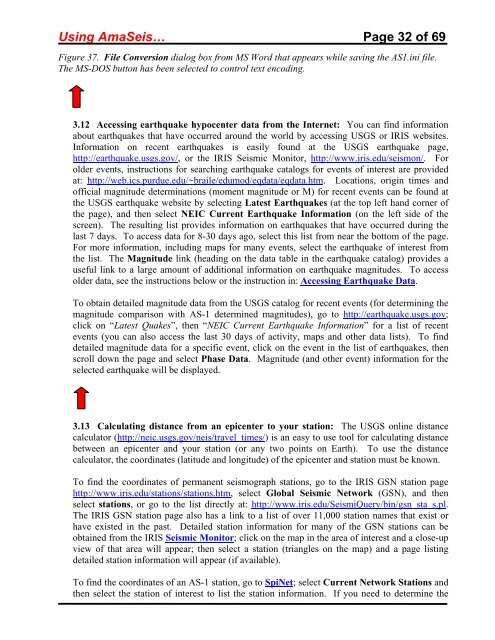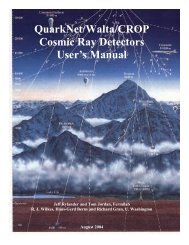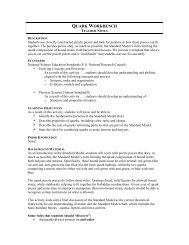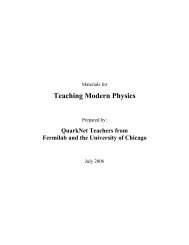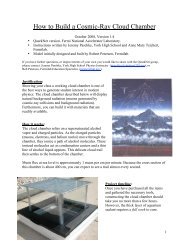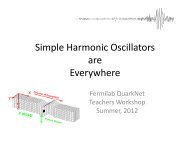Using the AmaSeis seismogram viewer and downloading - QuarkNet
Using the AmaSeis seismogram viewer and downloading - QuarkNet
Using the AmaSeis seismogram viewer and downloading - QuarkNet
Create successful ePaper yourself
Turn your PDF publications into a flip-book with our unique Google optimized e-Paper software.
<strong>Using</strong> <strong>AmaSeis</strong>… Page 32 of 69<br />
Figure 37. File Conversion dialog box from MS Word that appears while saving <strong>the</strong> AS1.ini file.<br />
The MS-DOS button has been selected to control text encoding.<br />
3.12 Accessing earthquake hypocenter data from <strong>the</strong> Internet: You can find information<br />
about earthquakes that have occurred around <strong>the</strong> world by accessing USGS or IRIS websites.<br />
Information on recent earthquakes is easily found at <strong>the</strong> USGS earthquake page,<br />
http://earthquake.usgs.gov/, or <strong>the</strong> IRIS Seismic Monitor, http://www.iris.edu/seismon/. For<br />
older events, instructions for searching earthquake catalogs for events of interest are provided<br />
at: http://web.ics.purdue.edu/~braile/edumod/eqdata/eqdata.htm. Locations, origin times <strong>and</strong><br />
official magnitude determinations (moment magnitude or M) for recent events can be found at<br />
<strong>the</strong> USGS earthquake website by selecting Latest Earthquakes (at <strong>the</strong> top left h<strong>and</strong> corner of<br />
<strong>the</strong> page), <strong>and</strong> <strong>the</strong>n select NEIC Current Earthquake Information (on <strong>the</strong> left side of <strong>the</strong><br />
screen). The resulting list provides information on earthquakes that have occurred during <strong>the</strong><br />
last 7 days. To access data for 8-30 days ago, select this list from near <strong>the</strong> bottom of <strong>the</strong> page.<br />
For more information, including maps for many events, select <strong>the</strong> earthquake of interest from<br />
<strong>the</strong> list. The Magnitude link (heading on <strong>the</strong> data table in <strong>the</strong> earthquake catalog) provides a<br />
useful link to a large amount of additional information on earthquake magnitudes. To access<br />
older data, see <strong>the</strong> instructions below or <strong>the</strong> instruction in: Accessing Earthquake Data.<br />
To obtain detailed magnitude data from <strong>the</strong> USGS catalog for recent events (for determining <strong>the</strong><br />
magnitude comparison with AS-1 determined magnitudes), go to http://earthquake.usgs.gov;<br />
click on “Latest Quakes”, <strong>the</strong>n “NEIC Current Earthquake Information” for a list of recent<br />
events (you can also access <strong>the</strong> last 30 days of activity, maps <strong>and</strong> o<strong>the</strong>r data lists). To find<br />
detailed magnitude data for a specific event, click on <strong>the</strong> event in <strong>the</strong> list of earthquakes, <strong>the</strong>n<br />
scroll down <strong>the</strong> page <strong>and</strong> select Phase Data. Magnitude (<strong>and</strong> o<strong>the</strong>r event) information for <strong>the</strong><br />
selected earthquake will be displayed.<br />
3.13 Calculating distance from an epicenter to your station: The USGS online distance<br />
calculator (http://neic.usgs.gov/neis/travel_times/) is an easy to use tool for calculating distance<br />
between an epicenter <strong>and</strong> your station (or any two points on Earth). To use <strong>the</strong> distance<br />
calculator, <strong>the</strong> coordinates (latitude <strong>and</strong> longitude) of <strong>the</strong> epicenter <strong>and</strong> station must be known.<br />
To find <strong>the</strong> coordinates of permanent seismograph stations, go to <strong>the</strong> IRIS GSN station page<br />
http://www.iris.edu/stations/stations.htm, select Global Seismic Network (GSN), <strong>and</strong> <strong>the</strong>n<br />
select stations, or go to <strong>the</strong> list directly at: http://www.iris.edu/SeismiQuery/bin/gsn_sta_s.pl.<br />
The IRIS GSN station page also has a link to a list of over 11,000 station names that exist or<br />
have existed in <strong>the</strong> past. Detailed station information for many of <strong>the</strong> GSN stations can be<br />
obtained from <strong>the</strong> IRIS Seismic Monitor; click on <strong>the</strong> map in <strong>the</strong> area of interest <strong>and</strong> a close-up<br />
view of that area will appear; <strong>the</strong>n select a station (triangles on <strong>the</strong> map) <strong>and</strong> a page listing<br />
detailed station information will appear (if available).<br />
To find <strong>the</strong> coordinates of an AS-1 station, go to SpiNet; select Current Network Stations <strong>and</strong><br />
<strong>the</strong>n select <strong>the</strong> station of interest to list <strong>the</strong> station information. If you need to determine <strong>the</strong>


